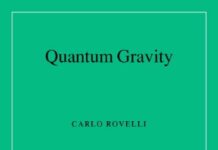
Ebook Info
- Published: 2018
- Number of pages: 252 pages
- Format: PDF
- File Size: 4.15 MB
- Authors: Carlo Rovelli
Description
One of TIME’s Ten Best Nonfiction Books of the Decade “Meet the new Stephen Hawking . . . The Order of Time is a dazzling book.” –The Sunday Times From the bestselling author of Seven Brief Lessons on Physics, Reality Is Not What It Seems, Helgoland, and Anaximander comes a concise, elegant exploration of time.Why do we remember the past and not the future? What does it mean for time to “flow”? Do we exist in time or does time exist in us? In lyric, accessible prose, Carlo Rovelli invites us to consider questions about the nature of time that continue to puzzle physicists and philosophers alike. For most readers this is unfamiliar terrain. We all experience time, but the more scientists learn about it, the more mysterious it remains. We think of it as uniform and universal, moving steadily from past to future, measured by clocks. Rovelli tears down these assumptions one by one, revealing a strange universe where at the most fundamental level time disappears. He explains how the theory of quantum gravity attempts to understand and give meaning to the resulting extreme landscape of this timeless world. Weaving together ideas from philosophy, science and literature, he suggests that our perception of the flow of time depends on our perspective, better understood starting from the structure of our brain and emotions than from the physical universe. Already a bestseller in Italy, and written with the poetic vitality that made Seven Brief Lessons on Physics so appealing, The Order of Time offers a profoundly intelligent, culturally rich, novel appreciation of the mysteries of time.
User’s Reviews
Reviews from Amazon users which were colected at the time this book was published on the website:
⭐Carlo Rovelli has the brilliance of Stephen Hawking and Albert Einstein and the communicative skills of Carl Sagan. Otherwise he is an Italian theoretical physicist that specializes in quantum gravity and is a proponent, if not quite an advocate, of loop theory. Beyond that he is a philosopher with a heart for ancient poetry and love.And he brings all of it to bear in this delightful book about time, which, in the end, is life, and everything, including the context in which it unfolds. It would be in error to suggest that time doesn’t exist, but it would be equally in error to suggest that time is as simple as the continuum we record with our clocks.What I like most about the book is the fact that Rovelli recognizes that philosophy and science, if not two sides of the same coin, are cousins. He refers to Proust, which few scientists do, and suggests that while reason is among the best tools available for interpreting our “collective delirium,” it is “only an instrument, a pincer.”The science and the prose are very accessible. You will, however, have to be willing to think abstractly, a skill that in our wired, binary world seems to be greatly dissipating. And he is the first scientist I have read in a while who takes time to explain why the problem is sometimes not the science itself, but the limitations of language. Language is a human construction and has not kept up with our scientific revelation. Which is why theoretical physicists sometimes seem to be speaking another language. If only there was another language that was constructed in the world as we know it today, our communication would be so much easier and our knowledge would expand more rapidly.It would be impossible to summarize the knowledge contained in this book. You really have to read it. Here is a start, however: “The world is not a collection of things, it is a collection of events.” If you can comprehend that the rest is largely additional perspective.And if the idea that universal time doesn’t exist in any absolute sense seems a stretch, consider Rovelli’s simple explanation (I’m paraphrasing): People never used to worry about clocks. They worried about the cycle of sunshine and darkness. But that cycle is different in every single village, town, and city on the planet. The cycle varies both east to west and north to south. And back when we used to spend our lives in our little village we didn’t care. But then the scientists and engineers invented trains to take us from one village to the next. And people needed to know when the train left their village. But how can you develop a timetable when every village has its own time? You can’t. But, at the same time, it’s not quite practical to say that the whole world has just one time. Farmers don’t care what the sun is doing in London. They care what it’s doing on their farm. (China actually has no time zones by edict. The entire country is on Beijing time and there are significant practical limitations.) The solution was the time zone, and it’s a compromise. Time zones are a construct and practical in the local sense, but highly inaccurate when talking about the universe. In the language of theoretical physics, they don’t exist.Eastern philosophers believe that reality is not knowable. It is real, but is made up of an infinite number of variables. We can only comprehend or think about a handful at a time. A tree is real. I can touch it and smell it. But it is not entirely knowable because there are too many variables (e.g. altitude, climate, soil, etc.) that define each tree for me to know them all. Time is the same way. Time is real but it is not knowable. Throw in the limitations of language and it begins to look like an illusion.To his great credit, Rovelli admits that there is much we don’t know. Think of a Seurat painting that has been blacked out. We have exposed a few, perhaps 10% (my number), of the original dots of pigment. It’s a lot, but we’re still guessing as to what the underlying picture is.And that’s pretty exciting. The key to our understanding to date, however, is the second law of thermodynamics which states that entropy can never decrease. It’s critical to our understanding of time, as Rovelli explains. Personally I’m not convinced it’s inviolate. Perhaps we just haven’t uncovered enough dots of pigment yet. If entropy could work both ways it would explain a lot, but attraction does not equal fact. (Entropy obviously has a big role in causality, of course. Bidirectional entropy would be a huge boost for inductive reason.)It’s a short book and even if you get through a small amount of it you will learn a lot. Beyond writing in an accessible way, Rovelli comes off as very personable. The perfect person to sit down and share a cup of coffee with. If only he had the time. (Sorry)A marvelous book that I highly recommend.
⭐Like consciousness, time is a subject that no philosopher or physicist has ever managed to nail down completely. Thanks to their slippery character, being so close to us (the first one IS us) they are endless sources for fountains of speculation. In this book, Rovelli’s subject is time, but consciousness comes into this narrative as well.Rovelli is a “time denier”. OK, that’s being a little unfair but not by much. What he denies is that there exists an independent, fundamental property or quality of the universe that is time. Of course the universe is full of movement and change, events unfolding into other events. His basic position is that time emerges into our perspective, our viewpoint, from these phenomena, but it is merely an illusion. The movement is real, the changing is real, but the time in which all of this seems to occur is nothing more than a manifestation of human (possibly animal) mind and the illusion, in turn, is supported by the entropy generated in the functioning of our brains.The book (not long read) is divided into three parts. In the first Rovelli covers the various sub-disciplines of physics and their temporal implications (or lack thereof). He begins with classical physics (the equations work backwards in time), and moves on to General and Special Relativity, and quantum mechanics. Here he demonstrates that our simple intuition of a universal time flowing from past to future is untenable. Time, mind-independent time, if it exists at all, cannot be like that. In part two he further demolishes time. Not only is it not what we think, in and for physics, it doesn’t really exist at all; even the present is an illusion! In part three, he puts time back together for and in the perspective of an subjective viewpoint.He argues it is the fact that we view the world from a perspective, that when we perceive the world we inevitably blur the details into a sort of summary or gestalt for our perspective, that causes time to appear to mind, The physics supporting that appearance comes down to thermodynamics. Human time, brain time, is “thermal time”. Certainly Rovelli thinks thermodynamics (in particular the 2nd law) is real, but while responsible for what consciousness perceives of time and so a real enough subjective experience, from the 3rd party perspective of physics, change is real, but time is a mirage.This book is written for a lay audience. There is almost no math in it (what there is appears in footnotes), and it defends a view common to much of the physics and philosophy community. To be sure Rovelli differs a bit from some of his peers. He argues that relativistic “block time” is no more a “true portrait of objective time” than any other theory. In Rovelli’s view remember there is no such thing as “objective time”.In 2015 a philosopher (Roberto Unger) and a physicist (Lee Smolin) wrote “The Singular Universe and the Reality of Time”. This book (reviewed by me on Amazon) makes precisely the opposite case from that of Rovelli. Of course they recognize what Relativity and quantum mechanics imply about time, but they maintain, nevertheless, that a notion (and reality) of objective, “universal time”, is more fundamental than any other phenomena of the universe, even more than space! Rovelli mentions this book in a footnote and admits that Unger and Smolin’s view “is defensible”, but he leaves it there and never addresses what is defensible about it.The Unger/Smolin book goes against the grain of 95% of today’s physicists. Personally I agree with Smolin and Unger. The fact (thanks to limiting effect of the speed of light) that we cannot map our present to any present in a remote galaxy, or even the nearest star does not mean there is no present there, in fact everywhere. Something is happening, NOW, everywhere in the universe. We do not know what it is, but that does not mean the present isn’t real as Rovelli believes. Had Rovelli directly addressed Unger and Smolin I would have given this book another star. Had he not mentioned them at all, I would have taken another away.In summary this is a decent and well written book advocating for a particular view of time (or no time) that I happen to think is wrong, but what do I know? It happens to be the dominant view in physics today. Rovelli is a well respected physicist and a good writer. Those of you interested in the subject will find this book valuable whether you agree with the author or not.
⭐A bit repetitive in explanations and could do with a preamble on entropy as much of the book relies on a good understanding of it (not just A dictionary definition). A book that needs to be re read once you have thought through what you have read. Make sure you have mastered what high and low entropy actually means before reading the book.
⭐An immensely enjoyable and thought-provoking book by Carlo Rovelli. He is a theoretical physicist, born in Italy but now working in France in the field of quantum-loop gravity – one of the contenders for the ’Theory of Everything’. He is also a big-hearted romantic ex-hippy whose love of life and humanity shines through this work.In the book he deals with time on the quantum level (essentially, time does not exist here) and at the level of the gravitational universe (in relativistic theory) where every part of the universe has it’s own, local, time. Then finally looking at time from the human perspective and how it might be built on the basis of entropy so that we see time as a series of events given direction by the increase in disorder as ‘time’ progresses.Many books on abstruse subjects leave you with a sense of bafflement – our human senses and sensibilities are built by evolution to deal with our world of trees, rivers and animals, not atoms and black holes. This book tackles this topic and leaves you with a sense of wonder and delight.Highly recommended.
⭐Railway time was synchronized as GMT by recommendation in the UK in 1847 (unlike Rovelli’s seemingly mistaken account on p55).If E=mc2 then the speed of light is relevant and constant. Speed is distance over time. Rovelli doesn’t even mention how this is reconciled with the points he is making.There seems no explanation of the use of time differences, synchronized to some sort of “now” in GPS. Presumably there has to be a “now” moment when information needs to be retrieved or sent to distant spacecraft.The age of the universe is often spoken about. What would that mean? Hmmm.A deeply unsatisfying book, at least for me and a very poor second to the clarity of eg. Stephen Hawking, Richard Feynman or now, quite a few others.
⭐This book is very well written and difficult to put down after starting to read it. It is a wonderful account of historical and current thinking on the nature of time. You will still be confused about this at the end of the book but you will realise you are not alone: scientists are confused also! Since Einstein most scientists accept that mass and motion affect time : the author says that the time at your head is different to the time at your feet for example. I think there is confusion between time and clocks. Clocks do not record time, they count ticks and the counting is certainly affected by mass and motion so a watch on your head would record a different count to a watch on your feet. The time , however, would be the same for both. The pendulum on a grandfather clock would stand still in zero gravity but time would go marching on.
⭐On the cover of the book Carlo Rovelli is termed “The Poet of Physics” and for once such book cover claim is not exaggeration. And given my mark of 5 out of 100 in my school Physics exam it is poetry I need rather than algebraic equations and constant reference to quantum leaps. Poetry. Our world is one of “becoming”, not “being”, of “events”, not “things”. Inter-being. Or as the poet himself expresses it:- “A kiss not a stone”. And humour too. Here is Mr Rovelli explaining that the events do not follow a precise time that is unvariable:- “The events of the world do not form an orderly queue, like the English. They crowd around chaotically, like Italians.” The prose of the author is humane. As an example, here he speaks of another physicist who he has admired but has now passed on (or passed back perhaps?) Rovelli writes tyat he “can no longer tell him I believe that he was the first to come close to the heart of the mystery of quantum gravity. Because he is no longer here – here and now. This is time for us. Memory and nostalgia. The pain of absence. But it isn’t absence that causes sorrow. It is affection and love. Without affection, without love, such absences would cause us no pain. For this reason, even the pain caused by absence is, in the end, something good and even beautiful, because it feeds on that which gives meaning to life.”This is fine. Humane. Science meets our humanity.Next stop the “Shobogenzo Uji of the Zen Master Dogen, who seemed to anticipate much of this in 13th century Japan, in his famous essay “Being-Time”. Being is time, and time is being. Dogen sought his very own time and place as we must continually seek and live in ours. The journey itself is home.Recommended.
Keywords
Free Download The Order of Time in PDF format
The Order of Time PDF Free Download
Download The Order of Time 2018 PDF Free
The Order of Time 2018 PDF Free Download
Download The Order of Time PDF
Free Download Ebook The Order of Time




